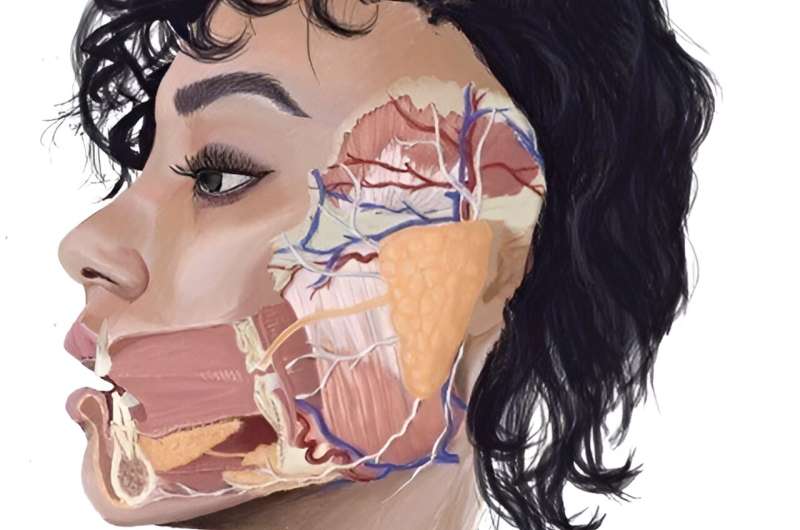This article has been reviewed according to Science X's editorial process and policies. Editors have highlighted the following attributes while ensuring the content's credibility:
fact-checked
trusted source
proofread
Research team creates anatomy repository to better reflect diversity

University of Calgary librarian Kathryn Ruddock had read about the lack of diversity in anatomy illustrations. As a visible minority librarian with a medical sciences background, the revelation struck a chord.
"I couldn't overlook it," says Ruddock, director of Digital Services with Libraries and Cultural Resources at UCalgary. So when Dr. Heather Jamniczky, Ph.D., the associate dean of Graduate Science Education at the Cumming School of Medicine (CSM), approached her to ask if the library had a repository for preserving and sharing the diverse anatomical resources her team was creating, Ruddock was thrilled.
The new Anatomy Video and Imagery Diversity (AVID) project, a joint initiative between UCalgary and the University of Windsor, is an answer to the lack of diversity represented in anatomy teaching materials. An idea first imagined by Jamniczky and University of Windsor Kinesiology professor Dr. David Andrews, Ph.D., and co-led by Drs. Sarah Anderson, Ph.D., and Lian Willetts, Ph.D., both assistant professors (teaching) with the Department of Cell Biology and Anatomy at the CSM, it is now a live repository housed within UCalgary library's Digital Collections.
Holding 64 original illustrations and 23 videos created by student artists from UCalgary and across Canada—some of them trained medical illustrators and digital content creators—the collection represents the spectrum of human diversity. Meticulously crafted, the art shows complex networks of arteries in the face and body, and detailed drawings of the musculoskeletal and nervous systems with variations in age and skin tone, ethnicity and body size.
Creators worked carefully with project leads to refine the resources, to ensure their accuracy and usefulness as teaching tools. Users can download the visuals at no cost using an attribution provided by the repository, ask questions about the artwork, and search for other images in similar tones.
The purpose of AVID is for students and the public to see themselves in the images used to teach about their bodies, say Drs. Anderson and Willetts.
Historically, anatomy textbooks typically showed images that depict males who are young, fit and white. The AVID project set out to meaningfully contribute to inclusivity and decolonialization, a movement that has been brewing at the grassroots level in the anatomy world, by producing an Open Educational Resource repository of original human anatomical images and videos to support education across many disciplines.
A key component of the project was inviting students who were historically underrepresented in health sciences education to be involved as paid co-creators, and to improve the visibility and representation of these students in the anatomical sciences.
"Much of the current instructional resources typically lack diversity in visual representation on elements such as race, gender, age, skin tone, ability and body composition," Anderson says. "This perpetuates a harmful hidden curriculum of bias against individuals who do not align with the dominant white male representation as the 'universal model' of the human form. It has negative implications for learner sense of belonging and care of our community members."
Mehr Malhotra, a UCalgary Master of Medical Science student specializing in Molecular and Medical Genetics is a video actor with the AVID project. She says the experience allows her to feel seen and represented in educational materials. "Being a woman of color, I've never seen anyone who looked like me in an anatomy textbook, which I thought was normal. I'm grateful for the opportunity to participate in AVID, to add to the diversity of anatomy resources and normalize the presence of underrepresented populations in medical education."
Malhotra values how the initiative promotes diversity and inclusivity in education. "Featuring real people, rather than prototypical anatomical models, allows students to better visualize and understand varying physical features, body compositions, and movements that better represent the Canadian population."
UCalgary medical student and trained medical illustrator Angélica Ortiz appreciates that the illustrations will be available to everyone and values that the project incorporates ethnic and cultural diversity. As a former graduate student of biomedical communications, she excels at illustrating anatomy and enjoys the work as a complement to her medical studies.
University of Windsor Kinesiology student collaborators Rahul Seehra and Peyton Bost helped create the skeletal system videos for the project. Seehra values the open-access nature of the educational resources, stating, "Regardless of where someone is from or what their level of knowledge is, they can use the images and videos to learn. I think this project has the potential to impact many future students and others who are interested in anatomy."
Bost is excited to help contribute to the progress of anatomy education and hopes the team's collective efforts will have positive impacts for both teaching and learning. "I hope to create a sense of belonging and inclusivity for students while improving their understanding of anatomy."
One of the great highlights for Ruddock has been the ability to support all of these students as creators. "Facilitating the sharing of their work through our library platforms not only ensures their efforts are recognized and stable but also widely disseminated," she says.
As more diverse content is developed and housed within the library, the Libraries and Cultural Resources team is committed to ensuring the repository is as accessible as other similar open anatomy materials, she adds.
"I believe that introducing more diversity into the world through this work not only fosters a sense of inclusion but subtly influences societal perceptions," says Ruddock. "Many will feel the impact."
More information: Anatomy Video and Imagery Diversity (AVID) Project



















